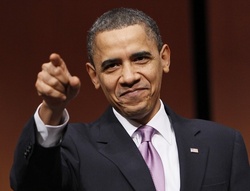President Barack Obama signs student loan changes into law
WASHINGTON (AP) - President Barack Obama approved legislation Tuesday that makes the government the primary issuer of student loans.
Proponents of the change say it will provide bigger grants for college students who need them and relaxed payment terms for students with loans. It will also more money available for community colleges and historically black institutions

President Barack Obama signed changes in student loans into law Tuesday.
On the other side of the coin, banks and other financial institutions stand to lose. Sallie Mae, the biggest student lender, has about 8,500 employees working for the student loan program and has said close to one-third of them may lose their jobs as a result of the overhaul. Sallie Mae still will have contracts to service federal loans.
Read on for more information about whom the change will affect and how. Do you support the changes? Take our poll and tell us what you think in the comments section below.
Q: What does the overhaul of student lending do?
A: Basically, it cuts banks out of the government-backed student loan business. Money for the loans has come either directly from the government or through private financial institutions, which have collected billions of dollars in federal subsidies to protect against default.
Under the changes, banks will no longer act as middlemen, and all colleges and universities must switch to the direct lending program by July 1. Many already have made the switch in anticipation of the new law.
Private lenders can still make student loans that are not backed by the government, and they will continue to have contracts to service some federal loans. But the new law represents a significant change in what has been a multibillion-dollar business for the banking industry.
Q: How much money will the government save?
A: Taxpayers will save $68 billion over the next 11 years, according to the Congressional Budget Office.
Q: What will Obama do with the money? How will this affect students and their parents?
A: A chunk of the savings will go toward Pell Grants for college students. The money will provide more grants and grants for larger amounts. Community colleges and institutions with predominantly minority populations also will receive funding.
Q: Will the changes bring down college costs?
A: Sorry, no. Obama acknowledged as much before signing the bill when he urged colleges and universities to "do their part" to hold down costs.
Q: What exactly is happening to Pell Grants?
A: More than $40 billion will go toward the grants, which are targeted toward students from low- and moderate-income families. Between 2013 and 2017, the maximum award will increase to $5,975 from $5,550. The administration also expects more than 820,000 additional awards to be made by the 2020-2021 academic year because of the changes.
Some of the money will address shortfalls in the Pell Grant program that developed because students were qualifying for more and larger grants. More than 6 million students received such grants in the 2008-09 academic year, an increase of about 50 percent from a decade earlier, according to the College Board.
Q: How else will students benefit?
A: Students who have low incomes or meet certain other eligibility requirements and who take out loans after July 1, 2014, will see their payments limited to 10 percent of their discretionary income after graduation. Current law caps payments at 15 percent of income.
For students who make their loan payments on time, the government will forgive the balance after 20 years, instead of 25. Public service workers — teachers, nurses, police officers and those in the military — will see any remaining debt forgiven after just 10 years of repayment.
Q: What's in the new law for community colleges?
Community colleges, which enroll more than 6 million students and are growing fast, will receive $2 billion over the next four years for a competitive grant program to provide training and education programs. The grant program was created in the economic stimulus bill enacted last year, but never funded.
Q: What about funding for institutions that serve mostly minority student bodies?
These colleges and universities will share $2.55 billion in additional funding over the next decade.


Comments
GB
Thu, Apr 1, 2010 : 2:03 p.m.
I am all for private enterprise.... not government programs. Given time, the government will bankrupt this one too!!
leaguebus
Wed, Mar 31, 2010 : 9:33 p.m.
From 1992 to 2004, the private loan guarantees cost the government $39 billion, while the governments loans only cost $3 billion. Sallie Mae and other student lenders received $9 billion this year in subsidies this year. A Sallie Mae loan interest rate, made with bail out money, can be as high as 18% a year, with penalties much like credit card penalties. Its an adjustable rate loan and makes billions for Sallie Mae. Its Chairman just built a $250 million private golf course for himself. I know about this because I have a student that needs money to pay for his rent and Sallie Mae wants to charge him 10.5% on an adjustable rate loan. On top of this I have to cosign. There is no risk to Sallie Mae, they receive a subsidy to process the loan and my son starts paying immediately on the loan. Thanks to Obama it will be easier to get a real student loan at lower interest rates and my son will not have to start paying on the loan until he graduates.
Archdan
Wed, Mar 31, 2010 : 2:13 p.m.
How EXACTLY will the government SAVE money? If someone knows this please answer.
linuxtuxguy
Wed, Mar 31, 2010 : 1:34 p.m.
"It will also more money available for..." Shouldn't there be another word in there somewhere?